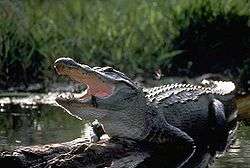Definify.com
Definition 2025
鰐
鰐
See also: 鳄
Translingual
Han character
鰐 (radical 195 魚+9, 20 strokes, cangjie input 弓火口口尸 (NFRRS))
References
- KangXi: page 1475, character 1
- Dai Kanwa Jiten: character 46337
- Dae Jaweon: page 2006, character 28
- Hanyu Da Zidian: volume 7, page 4701, character 18
- Unihan data for U+9C10
Japanese
Kanji
鰐
(uncommon “Hyōgai” kanji, shinjitai kanji, kyūjitai form 鱷)
Readings
Compounds
Compounds
|
Etymology

鰐 (wani): a crocodile.
| Kanji in this term |
|---|
| 鰐 |
|
わに Hyōgaiji |
| kun'yomi |
From Old Japanese. Derivation uncertain. Appears in the Kojiki in ambiguous reference to a kind of sea creature (possibly sharks[1] or crocodiles). The sense of crocodile clearly appears in the Wamyō Ruijushō dictionary (938) with an explanation of “having four legs like a turtle and a three-foot mouth with sharp teeth.”
Various theories exist regarding the term's origin, such as an alteration of 鬼 (oni, “demon, devil”), or an abbreviation of 海主 (watanushi, “sea master, sea god”).
Pronunciation
Noun
- crocodilian (crocodile, alligator, gavial)
- (obsolete) a shark or other large and dangerous fish
- 898-901, Shinsen Jikyō (volume 9 page 2)
- 鰐 五各反 和尓
- 898-901, Shinsen Jikyō (volume 9 page 2)
Derived terms
Derived terms
|
Idioms
Idioms
References
- Shōjū; Kyōto Daigaku Bungakubu Kokugogaku Kokubungaku Kenkyūshitu (898–901) Shinsen Jikyō (Zōteiban) (in Japanese), Kyōto: Rinsen, ISBN 978-4-653-00029-7, published 15 December 1967.
Korean
Hanja
鰐 • (ak) (hangeul 악, revised ak, McCune-Reischauer ak, Yale ak)
Synonyms
- 鱷 (악, ag)
Compounds
See also
- 鯢 (예, ye) salamander